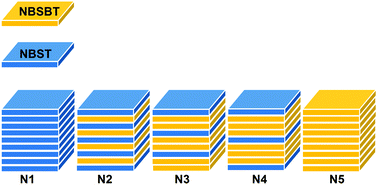Constructing layered structures to enhance the breakdown strength and energy density of Na0.5Bi0.5TiO3-based lead-free dielectric ceramics
Abstract
The improvement of breakdown strength for NBT-based ceramics is currently the main challenge in applications of lead-free dielectric energy-storage materials. In this study, large-polarization 0.65Na0.5Bi0.5TiO3–0.35SrTiO3 (NBST) and high-efficiency 0.45Na0.5Bi0.5TiO3–0.55Sr0.7Bi0.2TiO3 (NBSBT) ceramics were selected to construct layered ceramics. The effect of the number of interfaces on breakdown behavior and polarization was investigated by controlling the stacking of layered ceramics. The single-layer NBST/NBSBT alternately stacked layered ceramics achieved a maximum breakdown strength of 242 kV cm−1, resulting in high recoverable energy storage density (4.48 J cm−3) and efficiency (∼90%). Meanwhile, the energy storage performance of NBST/NBSBT layered ceramics also exhibits excellent frequency (10–200 Hz) and temperature (25–125 °C) stability. The results prove that the large number of interfaces is beneficial to obtain high breakdown strength and maximum polarization, which brings new enlightenment to further improve the energy storage density of NBT-based materials.



 Please wait while we load your content...
Please wait while we load your content...